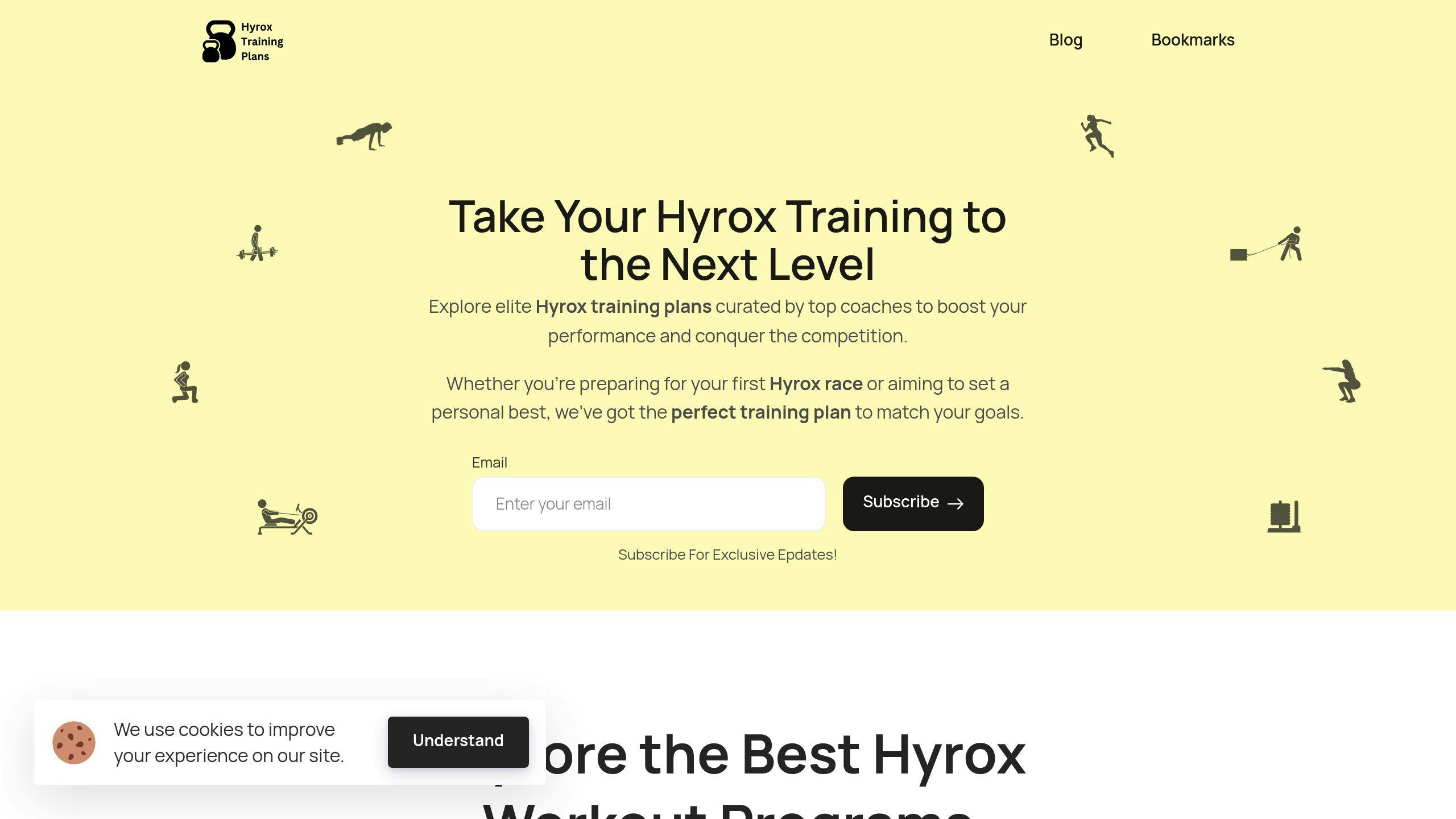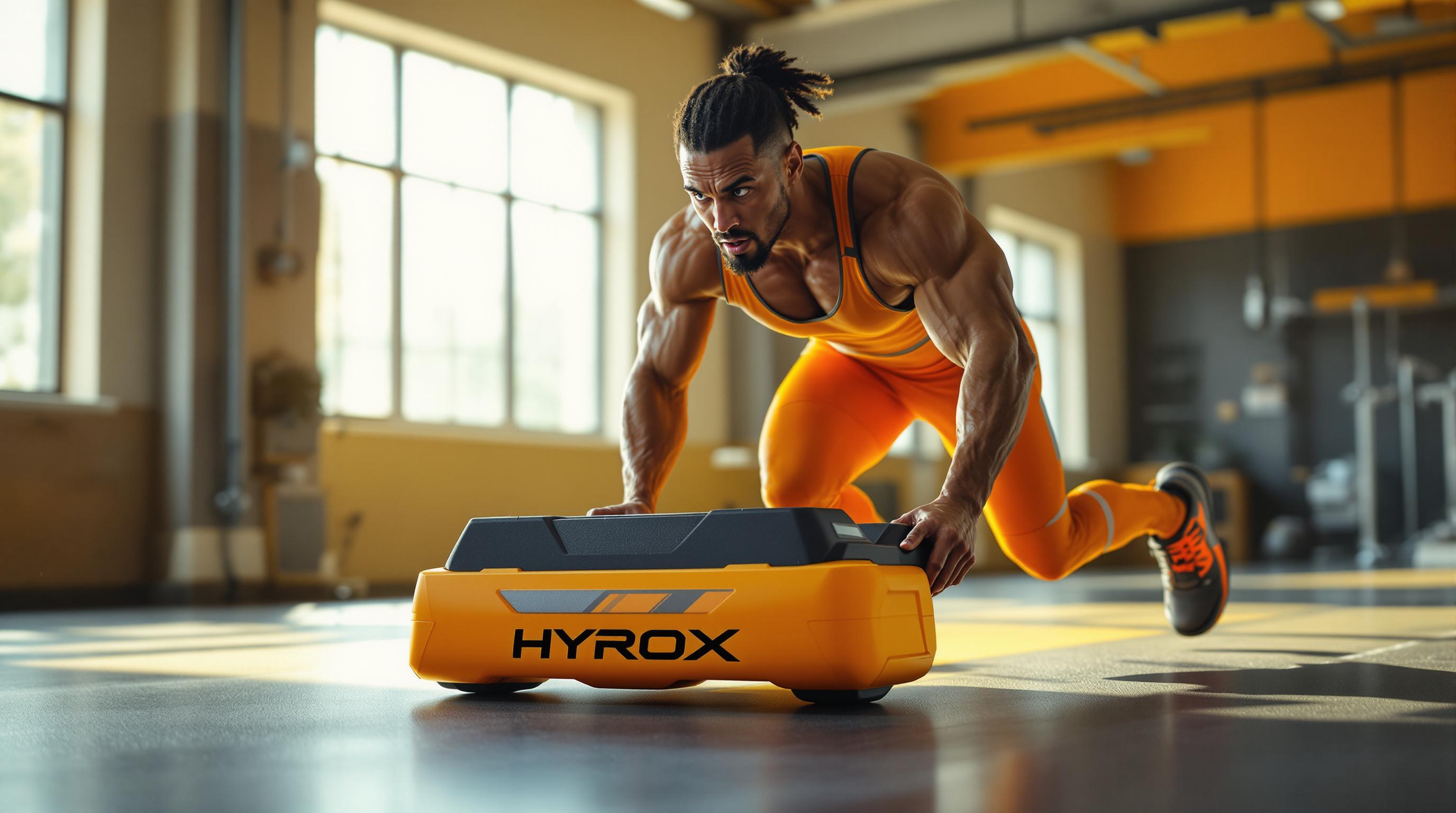Want to improve your Hyrox race performance? Focus on transitions. These are the moments when you switch between running and workout stations, and they can make or break your race. Mastering transitions isn't just about speed - it's about efficiency, energy management, and staying mentally sharp. Here's what you need to know:
- Why Transitions Matter: Saving 3-5 seconds per transition can improve your race time by up to 80 seconds.
- Key Transition Areas:
- Run to Station: Visualize movements, scan equipment, and prepare muscles in the final 300m.
- Station to Run: Release equipment quickly, control breathing, and maintain momentum.
- Techniques to Improve:
- Practice drills like sprints, gear handling, and mini-circuits.
- Simulate race conditions with pre-fatigue training and realistic setups.
- Advanced Tips for Teams: Use hand signals and positioning for smooth coordination in doubles events.
Pro Tip: Treat transitions as part of your workout, not a break. With consistent practice, you can save time without burning out.
Keep reading for drills, strategies, and training plans to refine your Hyrox transitions and boost your overall performance.
Everything You Need To Know For Race Day
Key Transition Areas in Hyrox Races

Transitions are a critical part of Hyrox races, and these two moments require focused strategies to maintain performance.
Transitions from Station to Run
Switching from workout stations to running segments is all about keeping your momentum while managing fatigue. Elite athlete Hunter McIntyre uses a "flying exit" technique, maintaining forward motion even as he releases equipment.
Here’s how to handle this transition effectively:
- Practice equipment release: Ensure you can release equipment quickly and within competition rules through regular practice.
- Control your breathing: Shift from intense station work to running by establishing a steady rhythm.
- Use landmarks: Focus on specific points as you leave stations to stay on course.
"Understanding the course layout is like having a cheat code. It allows you to mentally prepare for each transition before you even get there." - Mike Sarraille, Hyrox Pro Athlete
Transitions from Run to Station
While exiting stations tests your ability to keep speed, entering them requires you to prepare for the next challenge. Top athletes spend significantly less time in transitions compared to the middle of the pack, gaining precious seconds.
Key steps to prepare for station entries include:
- Last 300m: Start visualizing the movements required for the upcoming station.
- Last 200m: Scan the equipment layout to plan your approach.
- Last 100m: Engage the muscles needed for the next station activity.
In team formats, these strategies take on even greater importance. For doubles events, effective coordination is essential. Techniques like the "leapfrog" strategy can help teams recover strategically without losing pace. This concept will be explored further in Advanced Tactics.
Techniques for Improving Transition Speed
Mastering transitions isn't just about moving fast - it's about being efficient in time, energy, focus, and physical readiness. By honing specific techniques, you can make transitions smoother and more effective, saving precious seconds without exhausting yourself.
"We practice our transitions religiously. It's not just about speed, but also about conserving energy. A smooth, practiced transition can save you crucial seconds without burning you out." - Tom Hogan
This perspective aligns with Michael Trott’s view of transitions as untapped performance opportunities.
Proven Transition Drills
Incorporating targeted drills into your training can improve your ability to handle transitions under pressure. Below are three drills designed to sharpen your skills:
| Drill Type | Purpose | Implementation |
|---|---|---|
| Station-to-Run Sprints | Build explosive starts | Perform 50m sprints starting from exercises |
| Equipment Drop Practice | Improve gear handling efficiency | Practice quick release and storage of gear |
| Rapid Fire Stations | Build transition stamina | Complete mini-circuits with 2-3 exercises |
"Develop a transition mantra or checklist. This mental routine can anchor you when fatigue sets in, ensuring you maintain technique and efficiency." - Dr. Emma Ross
Race Condition Simulation
Training under realistic race conditions is one of the best ways to develop reliable transition skills. Athletes who simulate race environments during practice often see a 3-5% improvement in their overall Hyrox times.
Here’s how to make your simulations as effective as possible:
1. Environment Setup: Replicate the exact spacing of stations and use crowd noise through speakers to simulate race pressure.
2. Fatigue Management: Pre-fatigue your body with HIIT workouts before practicing transitions. This helps you stay efficient even when exhausted.
3. Equipment Variability: Train with different gear setups to prepare for race-day changes. Athletes who optimize their equipment handling can save 2-3 seconds per transition.
"The biggest mistake I see is people panicking in transitions. Stay calm, trust your training, and focus on smooth, practiced movements." - Sophia Thiel, Hyrox Champion
For best results, maintain steady breathing patterns during transitions to stay composed and in control.
"Transitions become automatic through drilling." - Florian Gast
sbb-itb-8bcd5e0
Advanced Tactics for Competitive Athletes
Top Hyrox athletes treat transitions as a skill of their own, dedicating time to practice and creating strategies to improve them.
Pacing for Transitions
Competitive athletes aim to distribute their effort evenly throughout the event, ensuring they have enough energy during transitions.
Here are three main areas to focus on for better pacing during transitions:
| Pacing Element | Strategy | Impact |
|---|---|---|
| Energy Distribution | Keep a steady heart rate between stations | Helps avoid early fatigue and speeds up recovery |
| Brief Recovery Moments | Use downtime during equipment changes | Targets specific muscle groups for quick recovery |
| Progressive Intensity | Increase speed after the event's midpoint | Maximizes performance during the final stretch |
"I try to keep my heart rate steady throughout the entire race. This helps me avoid burning out early and allows for smoother transitions between stations." - Florian Neuschwander
These tactics align with the energy management principles discussed in Why Transitions Matter.
Communication in Doubles Events
While solo competitors focus on personal execution, doubles teams must rely on strong coordination to make transitions smoother and faster.
"In doubles events, your partner is your greatest asset. Developing a seamless communication system can make or break your performance in transitions." - Lauren Weeks, Hyrox World Champion
To enhance teamwork, doubles athletes often use a "silent communication" system that includes:
| Method | Purpose |
|---|---|
| Hand signals | Provide quick status updates |
| Body positioning | Signal approach and readiness cues |
| Equipment coordination | Ensure smooth gear handoffs |
High-performing doubles teams practice these methods during intense training sessions to ensure their communication holds up under race-day pressure.
Hyrox Training Plans: Programs for Transition Practice

Hyrox Training Plans zeroes in on a crucial but often overlooked element of Hyrox competitions: transitions. These moments between stations can make or break your overall performance. Their programs take the transition techniques covered earlier and turn them into actionable improvements.
Here’s how they do it:
- Video Analysis Integration: Athletes can upload footage of their transitions for expert review. This allows for precise adjustments, helping to implement strategies like Michael Sarraille's 'course layout cheat code.' On average, this method cuts sled push setup times by 3-5 seconds.
- Progressive Fatigue Training: By simulating race-day conditions, these programs use "pre-fatigue" drills to help athletes handle transitions while under stress. Over 12 weeks, participants often see a 10-15% improvement in efficiency.
- Partner Communication Development: For doubles events, the focus is on building clear communication and coordination protocols to optimize team performance.
The programs are tailored to different skill levels:
| Level | Focus | Key Drills |
|---|---|---|
| Beginner | Core Techniques | Equipment setup, station orientation |
| Intermediate | Speed Development | Timed transitions, circuit combos |
| Advanced | Race Execution | Full-course simulations, doubles sync |
Athletes who’ve embraced these plans often see noticeable results. Sarah Johnson, a 2023 Hyrox World Championship Finalist, had this to say:
"Hyrox Training Plans revolutionized my approach to transitions. Their targeted drills shaved minutes off my race time."
The platform also incorporates a data tracking system that monitors metrics like setup efficiency, heart rate recovery, and movement quality. With consistent training, users typically see a 15-20% boost in efficiency within three months.
| Training Focus | Time Saved | Timeframe |
|---|---|---|
| Quick Changes | 10-15s per transition | 4-6 weeks |
| Equipment Setup | 3-5s per station | 8 weeks |
| Total Efficiency | 15-20% gain | 12 weeks |
Mastering Hyrox Transitions
Transitions in Hyrox competitions can be a game-changer. Building on the training methods and tactics discussed earlier, refining these in-between moments can give you a real edge on race day. With focused practice and smart strategies, you can turn transitions into a strength rather than a weak spot.
Here are three key areas to hone for better transitions:
- Equipment Management: Practice setting up and breaking down your equipment until it becomes automatic. The goal is to stay efficient, even when you're exhausted mid-race.
- Mental Preparation: Use visualization and breathing techniques to keep your focus sharp. Create mental cues for each station to help you stay calm and in the moment.
- Progressive Training: Start slow, focusing on perfecting your form. Once that's locked in, gradually increase your speed while keeping your technique intact.
"We practice our transitions religiously. It's not just about speed, but also about conserving energy. A smooth, practiced transition can save you crucial seconds without burning you out." - Tom Hogan
The takeaway? Transitions aren't just about moving quickly - they're about moving efficiently. By consistently applying these strategies, you'll build the kind of smooth, confident transitions that can elevate your overall performance.



